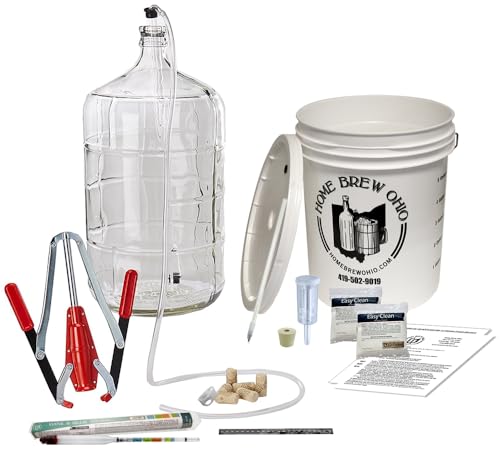candleboxcindy
Junior
Hey all, I made my very first batch last week and I'm very worried about what the outcome will be. Let me enumerate the steps (and missteps) I took and would appreciate your feedback about whether it will be okay, you can be pragmatic and tell me if it's a waste and better throw the batch out (because I have about 50KG grapes left hanging in the vine that I should harvest) or if I can do something to salvage this.
a. 26-Sep harvested about 11kgs grapes. Some of the grapes are infected with fungus or mildew so I took the painstaking step of manually removing infested ones, also cracked/crushed ones and destemming and washing each and every single good grape. While the grapes are still wet from the rinse, I immediately crushed them in a giant stainless steel crackpot, and let it macerate overnight. I was doubting about adding sulphite. Decided not to, since I washed the grapes. I also 'heard' that sulphite could result in a bad hangover, not sure if true.
b. 27-Sep Handpressed the grapes and using a stainless steel fine sieve I put the juice in my 30L container with airlock. I guess I'll be making white wine
c. Once the juice - now measuring at 7L - sits cozy in the container, I measured SG using my hydrometer. It shows 1.050 which means potential alcohol is low. But I ran out of sugar.
d. 28-Sep I bought crystallized white sugar and put 490g to 7L to yank up the sugar g/L.
e. I then tried an acidity measurement with the acidometer. I am not sure if I did it right, because no matter how much I added (of the blue liquid, supposedly Alkaline) the color doesn't change much after I shake it. Ultimately it sort of 'changed' at about 9g/L. I have an instruction document (from the supplier of the winemaking kit I bought) that says for white wine it should be around 7g/L and deviations from this can be corrected by adding Mixacid or Desacid. I did not do anything about this.
f. I also then proceeded to add my yeast. I made a HUGE MISTAKE because I was not focused. I was supposed to add 1.5g of yeast and dilute it in 10x water (which is 15ml). Instead, I put 1.5L of water!!! :-(
g. I added 0.7g of Nutrisal. Probably useless because the yeast didn't take hold?
h. In any case, fermentation seemed to be starting. The container's lid is bloated and the water in the airlock is pushing out.
i. 30-Sep I added another 0.7g of Nutrisal.
j. I took a measure using hydrometer to see the SG and it's now around 1.035 or so.
Today 2-Oct there doesn't seem to be a lot going on with the batch. What, in your opinion, should I do next? Thanks in advanced!
-----------
P.S. For my Batch 2 I harvested 21.5kg of grapes, and added Zymex as prescribed in the recipe. It immediately gave the crushed fruit/must a more vibrant reddish color. That batch is macerating now for 4 days and I have added the correct yeast-water ratio plus Nutrisal.
a. 26-Sep harvested about 11kgs grapes. Some of the grapes are infected with fungus or mildew so I took the painstaking step of manually removing infested ones, also cracked/crushed ones and destemming and washing each and every single good grape. While the grapes are still wet from the rinse, I immediately crushed them in a giant stainless steel crackpot, and let it macerate overnight. I was doubting about adding sulphite. Decided not to, since I washed the grapes. I also 'heard' that sulphite could result in a bad hangover, not sure if true.
b. 27-Sep Handpressed the grapes and using a stainless steel fine sieve I put the juice in my 30L container with airlock. I guess I'll be making white wine
c. Once the juice - now measuring at 7L - sits cozy in the container, I measured SG using my hydrometer. It shows 1.050 which means potential alcohol is low. But I ran out of sugar.
d. 28-Sep I bought crystallized white sugar and put 490g to 7L to yank up the sugar g/L.
e. I then tried an acidity measurement with the acidometer. I am not sure if I did it right, because no matter how much I added (of the blue liquid, supposedly Alkaline) the color doesn't change much after I shake it. Ultimately it sort of 'changed' at about 9g/L. I have an instruction document (from the supplier of the winemaking kit I bought) that says for white wine it should be around 7g/L and deviations from this can be corrected by adding Mixacid or Desacid. I did not do anything about this.
f. I also then proceeded to add my yeast. I made a HUGE MISTAKE because I was not focused. I was supposed to add 1.5g of yeast and dilute it in 10x water (which is 15ml). Instead, I put 1.5L of water!!! :-(
g. I added 0.7g of Nutrisal. Probably useless because the yeast didn't take hold?
h. In any case, fermentation seemed to be starting. The container's lid is bloated and the water in the airlock is pushing out.
i. 30-Sep I added another 0.7g of Nutrisal.
j. I took a measure using hydrometer to see the SG and it's now around 1.035 or so.
Today 2-Oct there doesn't seem to be a lot going on with the batch. What, in your opinion, should I do next? Thanks in advanced!
-----------
P.S. For my Batch 2 I harvested 21.5kg of grapes, and added Zymex as prescribed in the recipe. It immediately gave the crushed fruit/must a more vibrant reddish color. That batch is macerating now for 4 days and I have added the correct yeast-water ratio plus Nutrisal.
Last edited:























































